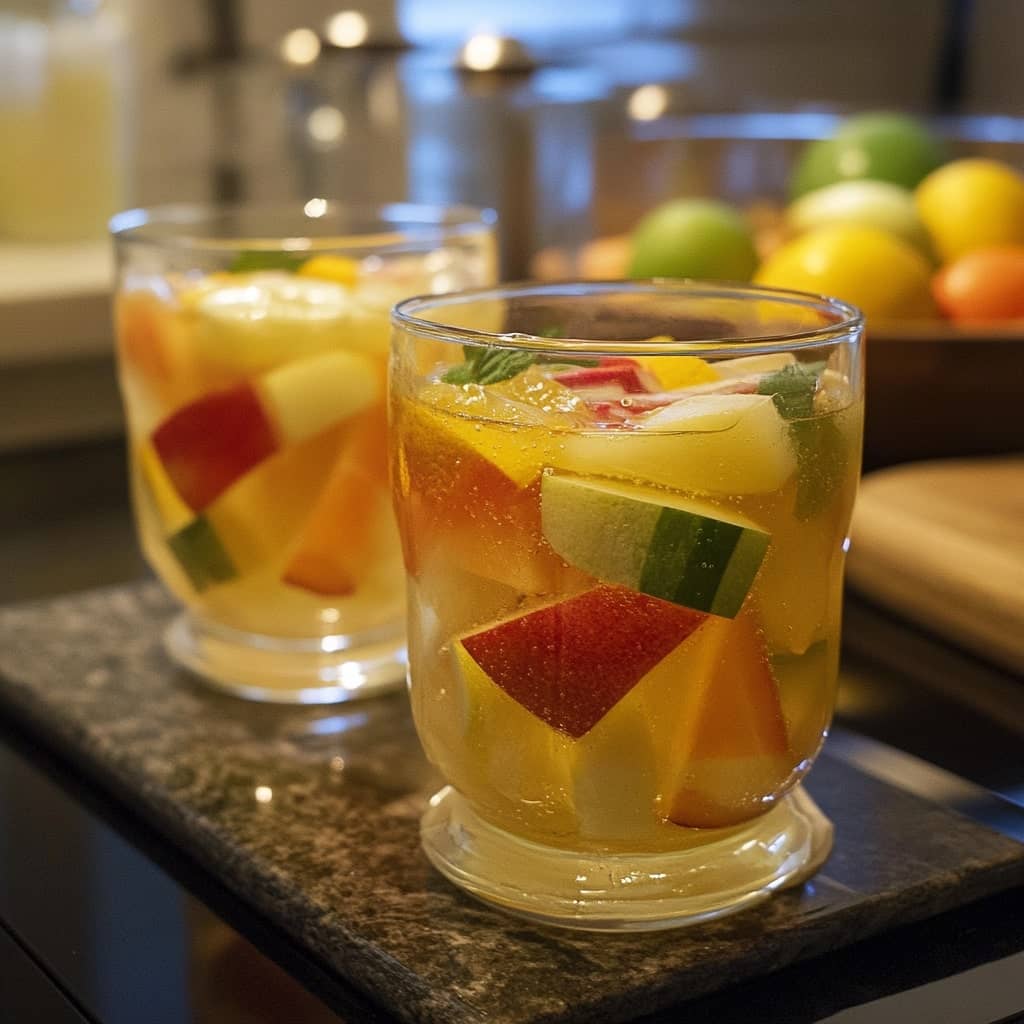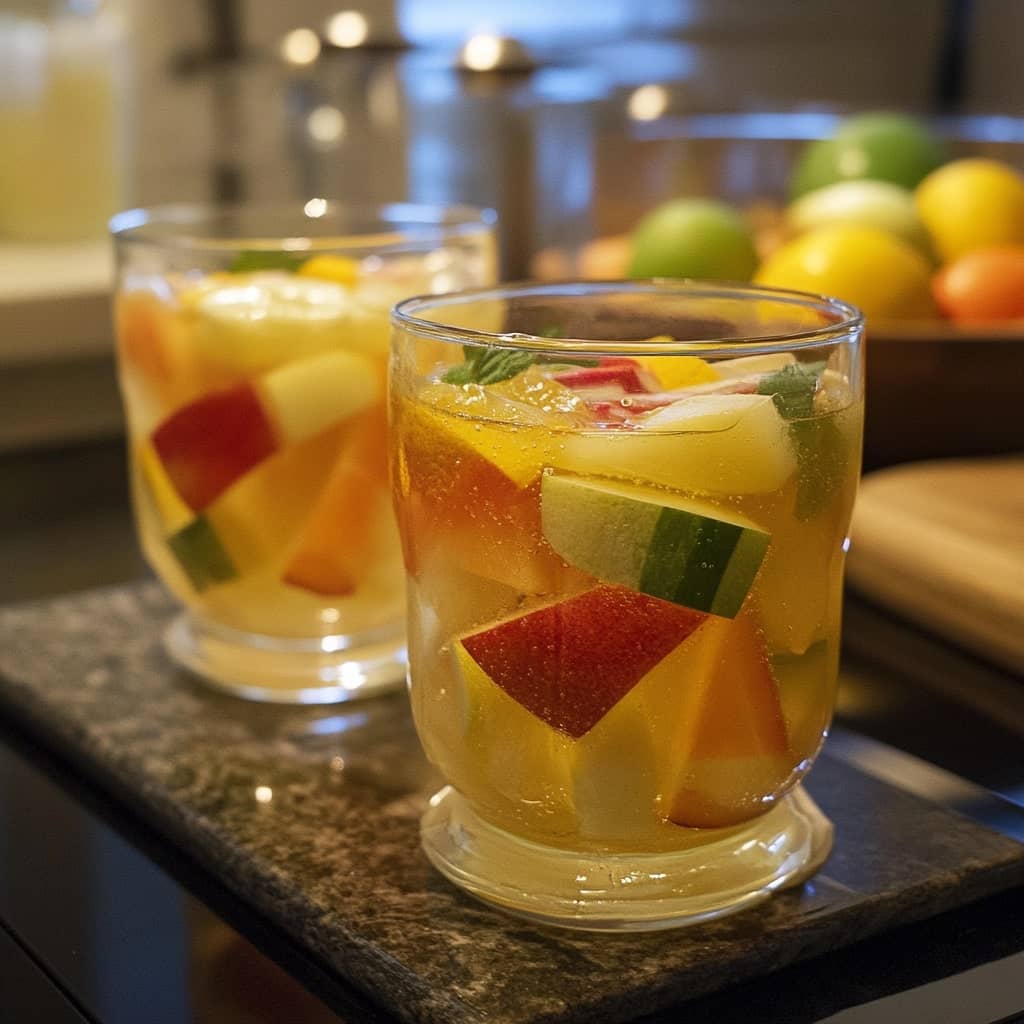Introduction
White Sangria is a delightful, refreshing twist on the classic Spanish sangria, made with white wine as the base instead of red. Known for its crisp and fruity flavors, it is a perfect drink for warm weather gatherings, brunches, or casual parties. With its vibrant mix of citrus fruits and other fruits like berries or peaches, white sangria is known for its light, sweet taste with a slight hint of tanginess. This beverage offers a fun and festive way to enjoy wine, and can be made in advance for ultimate convenience. Whether served chilled or over ice, white sangria is an easy-to-make crowd-pleaser that adds an elegant yet fun touch to any occasion.
The History of White Sangria
Sangria is believed to have originated in Spain, where the tradition of mixing wine with fruit dates back centuries. The red version of sangria is more commonly known, but white sangria has gained popularity in recent years, especially in regions with warmer climates where a cooler, lighter beverage is preferred. The drink is often associated with summer and festive gatherings, and while its exact origins are unknown, the mix of fruits, wine, and sometimes a splash of brandy has made it a beloved part of Spanish cuisine. Over time, variations of sangria, including white sangria, have evolved, with different fruits, flavors, and sweeteners being used depending on personal preferences and regional traditions.
Ingredients Breakdown
The key ingredients for white sangria include white wine, typically dry or semi-dry varieties like Sauvignon Blanc, Pinot Grigio, or Chardonnay, which serve as the drink’s base. Fresh fruits, such as citrus fruits like oranges and lemons, are essential for their bright, zesty flavors. Other fruits, like apples, berries, peaches, or even tropical fruits like pineapples, are also commonly added for extra sweetness and texture. A splash of fruit juice, typically orange juice or pineapple juice, adds a layer of sweetness and tanginess. A sweetener like honey, agave syrup, or sugar is often used to balance out the tartness of the fruit and wine. For an extra kick, brandy or other spirits can be included. Finally, sparkling water or soda water can be added for some fizz and a refreshing finish.
Step-by-Step Recipe
- Start by selecting a quality white wine, such as a dry Sauvignon Blanc or Pinot Grigio. Pour about 750 ml (1 bottle) into a large pitcher or bowl.
- Slice fresh fruits such as one orange, one lemon, and one apple into thin wedges or chunks. If you prefer, you can also add berries, peaches, or pineapples.
- Add the fruit to the wine, stirring gently to combine. You can also include a handful of mint leaves or a cinnamon stick for additional flavor.
- If you’d like to add sweetness, stir in 2-3 tablespoons of sugar, honey, or agave syrup to taste. You can adjust the sweetness depending on your preference.
- For an extra kick, add about 1/4 cup of brandy or a flavored liqueur like triple sec.
- If you’d like a bit of fizz, pour in 1-2 cups of sparkling water or club soda just before serving to maintain its effervescence.
- Refrigerate the sangria for at least 2 hours, allowing the flavors to meld together. If possible, leave it overnight for even more enhanced flavors.
- When serving, pour the sangria into glasses filled with ice. Garnish with extra citrus slices, berries, or fresh mint leaves.
Tips for the Perfect White Sangria
To make the perfect white sangria, it’s important to use a good quality wine but one that isn’t too expensive since it’s mixed with fruit. Avoid overly sweet wines as they can make the sangria too cloying. Fresh fruits are essential for balancing the wine’s acidity, and the longer you let the mixture chill, the more the flavors will blend. If you want to prepare it in advance, make it a day ahead of time for even better results. If you’re preparing the sangria for a large gathering, you can make a big batch in a large bowl or pitcher and add the sparkling water just before serving to keep it fizzy.
Variations and Customizations
While the classic white sangria recipe is delicious as is, there are plenty of variations and ways to customize the drink. Consider switching up the fruit by adding tropical options like mango, pineapple, or kiwi for a more exotic flair. For a more aromatic version, add a splash of elderflower liqueur or a dash of cinnamon for a warm, fragrant touch. You can also experiment with different sweeteners like maple syrup or brown sugar for a more complex flavor profile. If you prefer a lower-alcohol version, simply skip the brandy or reduce the amount. If you’d like to make it even more refreshing, consider adding cucumber slices or mint for a cool twist.
Health Considerations and Nutritional Value
White sangria is a relatively light and refreshing drink compared to other sugary cocktails, but it still contains alcohol, which should be consumed responsibly. The fruits in the sangria provide essential vitamins like vitamin C from citrus fruits and antioxidants from berries. However, it’s important to keep an eye on the added sweeteners, as they can increase the sugar content of the drink. To make a healthier version, consider using less sugar or substituting it with a natural sweetener like honey or agave syrup. Additionally, serving the sangria with a bit of sparkling water can reduce the calorie count while still providing a refreshing fizz. Always drink in moderation and enjoy the health benefits of the fruit ingredients!
FAQ
- Can I use red wine instead of white wine for sangria?
Yes, you can make red sangria by using a fruity red wine like Merlot or Zinfandel, but keep in mind that the flavor profile will change. - Can I make white sangria ahead of time?
Yes, white sangria can be made a day or two in advance for even better flavor as the fruits have time to infuse the wine. - Can I leave out the alcohol in white sangria?
Absolutely! For a non-alcoholic version, simply omit the brandy and enjoy the refreshing fruit flavors. - Can I use frozen fruit instead of fresh fruit?
Yes, frozen fruit can be used, but it may make the sangria a bit more watery once thawed. For best results, use fresh fruit or freeze your own fruits ahead of time.

White Sangria
Ingredients
Method
- Add lime, lemon, and sugar (or your chosen sweetener) to a large pitcher (or multiple pitchers if preparing a larger batch) and muddle using a muddler or gently crush with a wooden spoon for 45 seconds.
- Add apple brandy and muddle again for about 30 seconds to combine. Then, add apple, nectarine, and strawberries, stirring to incorporate. Add the wine and stir again.
- Taste and adjust the flavor as needed, adding more sweetener for sweetness, extra lime or lemon juice for acidity, or additional fruit. Stir to combine.
- Add ice or frozen berries and stir again to chill. Serve immediately, optionally garnished with mint. For a lighter version, top off each glass with a bit of sparkling water (optional).
- Store any leftovers in the refrigerator for up to 48 hours, though it’s best enjoyed within the first 1-2 days.
